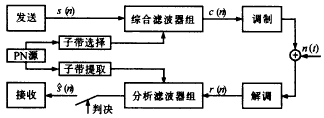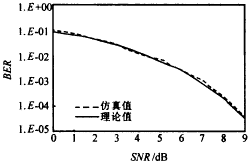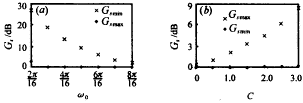Application of wavelet in spread spectrum communication
This paper describes the principle of multiple access communication based on orthogonal wavelet function family, and proposes a multi-rate orthogonal wavelet modulation method. Using wavelet functions with different scaling standards to encode the code streams in different channels can achieve extended information The purpose of sequence spectrum, so this multiple access technology has good anti-interference performance. This article also discusses other characteristics of this multiple access method, and puts forward some solutions to the problem of unequal channel capacity.
Keywords: wavelet; multiple access communication; modulation; spread spectrum
The ApplicaTIons of Wavelet in Spread Spectrum CommunicaTIons
WU Hao, SONG Wen-tao, LUO Han-wen
(Dept. of Electronic Engineering, Shanghai Jiaotong Univ., Shanghai 200030, China)
Abstract: The principle of mulTIple access communicaTIon is described, which is based on the orthogonal wavelets in this paper.And a multirate orthogonal modulation scheme is proposed.The goal of spreading information sequence spectrum is met by coding bit-streams with the different scaled wavelets .So this multiple access technology has a good performance in resisting narrow jam and interference.The other characteristics are also discussed.Some methods are given to resolve the inequity of the channel capacity.
Key words: wavelet; multiple access communications; modulation; spread spectrum
1. Introduction In recent years, wavelet analysis methods have been widely used in many communication fields such as signal detection, multi-scale edge extraction, speech and image processing [7, 8]. In the field of spread spectrum communication, based on orthogonal wavelet function family Multiple access spread spectrum technology has also been proposed [1], and is called SDMA (scale-division multiple access, scale division multiple access). Now widely used CDMA technology is to use pseudo-random sequence to spread spectrum, the approximate Orthogonal pseudo-noise sequences have strong anti-narrowband noise performance; SDMA uses orthogonal wavelet function family to complete spread spectrum, also has similar performance. However, in CDMA systems, information is transmitted on the same frequency band Narrowband noise will contaminate the entire information stream; while in SDMA systems, information is distributed to different subbands for transmission, narrowband noise will only contaminate part of the information stream. Therefore, the system performance of SDMA is better than CDMA. SDMA will be explained separately below The principle, modulation and demodulation model and the characteristics of SDMA, and finally give the conclusion.
Second, the basic theory of SDMA spread spectrum wavelet analysis provides a strong theoretical basis for finding a suitable family of orthogonal wavelet functions, and is also the mathematical foundation of SDMA. The wavelet function is defined as
![]() (1)
(1)
Where w (t) is called the basic wavelet. In practical applications, usually two wavelets are used, defined as
ψmn (t) 2m / 2ψ (2mt-n) (2)
According to the nature of the wavelet function, <ψmn.ψkl> = δm, kδn, l, where δi, j = ![]() For any signal x (t), its discrete binary wavelet transform and inverse transform are
For any signal x (t), its discrete binary wavelet transform and inverse transform are
xmn = ∫ + ∞-∞x (t) ψmn (t) dt (3a) ![]() (3b)
(3b)
Now consider M binary code streams sm ∈ {0, 1}, m = 1, 2, ..., M. For the orthogonal set ψmnT on L2 (R), sm can be combined into
![]() (4)
(4)
Where n represents the nth bit of a sequence, and T is the duration of a bit. Therefore, the demodulation of the signal at the receiving end is based on (3b) wavelet transform of c (t) to extract the sequence sm. The following equation ( 4) Start to derive the power spectrum expression of c (t).
The autocorrelation function of c (t) is

Assume that the information sequence {sm (n)}, m = 1,2, ..., M is a generalized stationary process, and its autocorrelation function is defined as Rss (k) = E ï¼»s * m (n) .sm (n + k )],and so

Because c (t) is a generalized periodic stationary process, there are
![]() (5)
(5)
The power spectral density expression of c (t) is obtained from the Fourier transform of equation (5)
![]() (6)
(6)
among them ![]() And define the spectral density of the information sequence as
And define the spectral density of the information sequence as
![]()
Substituting into equation (6) gives a further expression of Φcc (ω)
![]() (7)
(7)
It can be seen from equation (7) that after the information sequence is encoded by wavelet transform, its spectrum is expanded, and the spreading coefficient η = 2m, m> 0. It can be seen that the spreading coefficient of each channel is different.
3. Modulation and demodulation model based on SDMA According to multi-resolution analysis theory, the modulation and demodulation of signal c (t) is the process of wavelet reconstruction and decomposition. To this end, another function φ∈L2 (R) is introduced, and φmn (t) = 2m / 2φ (2mt-n), so that the two spaces based on ψ and φ are orthogonal to each other, then there are two sequences {p (n)} and {q (n)} such that
![]() (8a)
(8a) ![]() (8b)
(8b) ![]() (8c)
(8c)
Let fj and gj be functions on two orthogonal spaces Vj and Wj with scale j, respectively, then they have a unique series representation:
![]() (9a)
(9a) ![]() (9b)
(9b)
From equations (8) and (9), the wavelet decomposition and reconstruction algorithm can be obtained
![]() (10a)
(10a) ![]() (10b)
(10b) ![]() (10c)
(10c)
In the case of limited resolution (ie m < ), Equation (4) can be rewritten as
![]() (11)
(11)
Received signal (t) = c (t) + n (t), n (t) is the channel noise, according to equation (11), the best receiver model can be obtained as
![]() (12)
(12)
SDMA modulation and demodulation model can be obtained by formula (10) ~ (12), as shown in Figure 1, 2.

Figure 1 SDMA's multi-rate modulation model |

Figure 2 SDMA multi-rate demodulation (best receiver) model In actual systems, there are always
Where Em is the average energy per symbol, and σ2 is the variance of AWGN. From equation (13), it can be seen that the bit error rate of each channel will be inconsistent. 4. The performance and characteristics of SDMA The previous analysis shows that the SDMA system has good anti-narrowband noise performance. At the same time, it can also make the transmitted signal similar to the background noise spectral characteristics by selecting the appropriate base wavelet w, making it very strong. The confidentiality of [2]. Similar to CDMA, only the receiver who knows w can get the information, and it is difficult for others to steal it; and it can also allow the sender to send information with different wavelets according to a certain rule (called wavelet hopping spread spectrum) to enhance system security, which is similar to frequency hopping spread spectrum (FH / SS). SDMA system distributes signal energy to different frequency subbands for transmission, which also makes the system highly resistant to narrowband noise Performance. In Figures 1 and 2, the transfer functions p (n), q (n) and p (-n), q (-n) are the realization of this allocation and its inverse process. These transfer functions can be used Cross-mirror filter (PR-QMF) group implementation. |

Figure 3 SDMA spread spectrum system model |

Figure 4 Single-user performance of SDMA system under AWGN channel |

Figure 5 Performance of two-user asynchronous CDMA system based on different spreading codes under AWGN channel (PR-QMF spreading factor is 32, and length of Gold sequence and M sequence is 31) In the previous analysis, it was mentioned that each channel of the SDMA system has different bit error rate and transmission rate. For the former, the bit error rate of each channel can be made close by power control; for the latter, the unfairness of this channel But it is inherent in the SDMA system. For users of the same service, let them use the same channel in a time-sharing manner to narrow the gap between the average transmission rates of each user. For example, in an odd time slot, user A uses sub-channel C1. B uses sub-channel C2; while even time slots, user A uses C2 and user B uses C1. For users with different services, this unfairness may be one of the advantages of SDMA systems: using high-rate channels to transmit broadband services ( Such as images), use low-rate channels to transmit narrow-band services (such as voice), and the system naturally combines these services together, so this will be suitable for transmitting multimedia signals.
Where σ2i is the variance of the output of the i-th analysis filter, and K is the number of layers of wavelet decomposition. The length of the synthesis / analysis filter is L (that is, the support length of the orthogonal wavelet, and it is even) and the given signal spectral density In the case of P (ω), the choice of the optimal wavelet that guarantees the best system performance comes down to |

(a) Evenly distributed, In the numerical analysis in Figure 6, the local optimal search results are used instead of the global optimal values, because there is currently no perfect algorithm for solving the global optimal results. In addition, when the spectral density of the signal is more complicated, the search is the most The complexity of the optimal results also increases accordingly. 5. Conclusion Wavelet analysis theory has been widely used in image processing, signal detection and other communication fields. Here, the principle of spread spectrum communication based on wavelet is discussed, a multi-rate modulation and demodulation model is proposed, and the AWGN is given. The performance simulation results of the system in the channel. Through analysis, it shows that the SDMA system has better anti-narrowband noise performance and confidentiality, and can be better suited for multimedia services. In order to make the system have stronger confidentiality, the power of the transmitted signal is required There is no obvious peak in the spectrum (even if the energy is distributed as evenly as possible in the frequency band), and the spectral structure of the fundamental wavelet w determines the spectral structure of the transmitted signal, so how to choose w to meet the above requirements needs further research; how to design orthogonal mirror filtering (PR-QMF) is also an important subject; the performance of SDMA systems with more than two users needs to be further explored. |
Universal Series Extension Sockets
Socket Extension,Trailing Socket,Plug Socket Extension,Single Socket Extension Lead
Heikki Technology Co., Ltd. , https://www.heikkipower.com